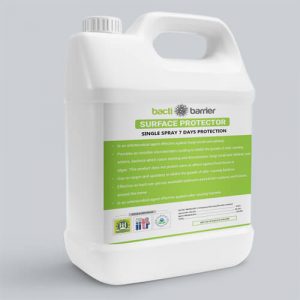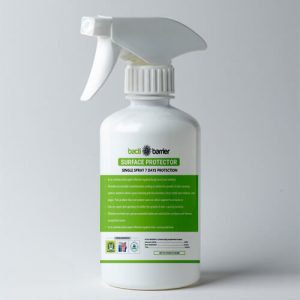Surface Protector
Showing all 3 results
Showing all 3 results
There are many toxigenic microbes on surfaces. The surface should be cleaned to ensure the Bacti Barrier surface coating provides the best results. For normal contamination, solid surfaces should be cleaned thoroughly before treatment. Soft surfaces such as carpets and upholstery should be vacuumed or professionally cleaned. Insulation can be cleaned and treated if only superficial growth is present. Insulation that has heavy growth or is damp should be removed and replaced.
Common Surfaces: Chairs, desks, countertops, door handles, common contact surfaces, bathroom surfaces, toilets, sinks, and kitchen surfaces.
Building Materials and Components: Wooden building materials, engineered lumber, plywood, flakeboard, oriented strand board, particleboard, fibreboard, sheathing, decking or planking, wallboard, vinyl siding, plastic siding, wood siding, concrete and concrete products, cinder blocks, brick, stone, ceiling tiles, architectural metal, louvers, vents, coping
Roofing Materials: Wood shingles, composite shingles, asphalt shingles, roofing granules, tiles, membranes, underlayment, wood shakes, felt, stone, concrete, asphalt coating, synthetic coating.
Insulation Materials: Cellulose insulation, fiberglass insulation, panel insulation, rigid foam, expanded foam, moisture and wind fabric barriers.
General Use Materials: Vinyl, plastic, wood, laminate, concrete, tile, stone, wallboard, gypsum board, plaster, EIFS wall systems, fiberglass, synthetic stucco, cinder block, brick, siding, wall paper, and wall coverings, carpet, underlayment, mats.
Fabric Materials: Acetates, acrylics, cotton, fiberglass, nylon, lycra, polyester, polyethylene, polyolefin, polypropylene, rayon, spandex, vinyl, wool, orlon, silk, natural down, and blends of these fibres.
Building Materials and Components: Wooden building materials, engineered lumber, plywood, flake board, oriented strand board, particle board, fiber board, sheathing, decking or planking, wall board, vinyl siding, plastic siding, wood siding, concrete and concrete products, cinder blocks, brick, stone, ceiling tiles, architectural metal, louvers, vents, coping.
Roofing Materials: Wood shingles, composite shingles, asphalt shingles, roofing granules, tiles, membranes, underlayment, wood shakes, felt, stone, concrete, asphalt coating, synthetic coating.
Insulation Materials: Cellulose insulation, fiberglass insulation, panel insulation, rigid foam, expanded foam, moisture and wind fabric barriers.
General Use Materials: Vinyl, plastic, wood, laminate, concrete, tile, stone, wallboard, gypsum board, plaster, EIFS wall systems, fiberglass, synthetic stucco, cinder block, brick, siding, wall paper and wall coverings, carpet, underlayment, mats.
Fabric Materials: Acetates, acrylics, cotton, fiberglass, nylon, lycra, polyester, polyethylene, polyolefin, polypropylene, rayon, spandex, vinyl, wool, orlon, silk, natural down, and blends of these fibres.
The newer and older solution-dyed carpets can be treated with the Bacti Barrier Cleaning System. Rugs/carpets need to be cleaned before application with a specially formulated carpet cleaning detergent to ensure the active ingredient in the formulation bonds. Like any cleaning detergent directions specify, all carpets and upholstery should be tested for dye fastness before treatment.
Surfaces should be cleaned thoroughly, and any residue from cleaning agents must be rinsed from the surfaces to be treated. The final rinse should come off without any signs of dirt or foaming from the cleaners. We have a compatible cleaning product that also is a disinfectant. The Bacti Barrier Cleaning System provides a perfect combination of cleaner and antimicrobial.
The active ingredient in the Bacti Barrier Coating is an antimicrobial that forms a colorless, odorless, positively charged polymer, which permanently bonds to the treated surface. You could think of it as a layer of electrically charged spears. When a microorganism comes in contact with the treated surface, the quaternary amine spear punctures the cell membrane and the electrical charge shocks the cell. Since nothing is transferred to the now dead cell, the antimicrobial doesn’t lose strength and the spear is ready for the next cell to contact it. Normal cleaning of treated surfaces is necessary to prevent the build-up of dirt, dead microbes, etc., which could cover the treatment, prohibiting it from killing microorganisms.
Since the cured antimicrobial is in-volatile, insoluble, and non-leaching, the treatment should last up to 90 days. The life of the treated surface depends on several factors, not the least of which is surface preparation. If you treat a dirty or unstable surface, when the dirt comes off or the surface is disturbed, the effectiveness of the antimicrobial will decrease. Abrasive or caustic (pH 12.0) cleaners will also shorten effective life. In our experience, our home office applicators have seen effectiveness for 90 days of the substrate with normal housekeeping.
The usage of bleach should be limited to situations where better performing and safer alternatives are not available. In the presence of organic matter (the everyday contamination we deal with), bleach loses effectiveness and requires an extra pre-cleaning step. The acidic nature of bleach often requires a secondary rinse. Also, diluted bleach starts to lose its effectiveness within a few hours and should be prepared daily to maintain its efficacy.
Long-term exposure to bleach has well-documented health consequences. And if that’s not enough reason to consider switching, prolonged use of bleach rapidly degrades furnishings and equipment, unnecessarily increasing your capital expenditures. In this day and age, we have much more effective and eco-friendly alternatives.
Of particular importance to many of our clients who are exposed to bleach on a daily basis, long-term exposure to bleach has well documented health consequences. And if that’s not enough of a reason to consider switching, prolonged use of bleach rapidly degrades furnishings and equipment, unnecessarily increasing your capital expenditures. In this day and age, we have much more effective and eco-friendly alternatives.
The nanotechnology ensures that daily sanitization is not required. The formula disinfects the surface for six months, providing you and your surrounding comprehensive safety.
The long molecular chain punctures and destroys the microbes through their cell membrane. The difference in charges caused electrocution, so no mutation and resistance occurs.


